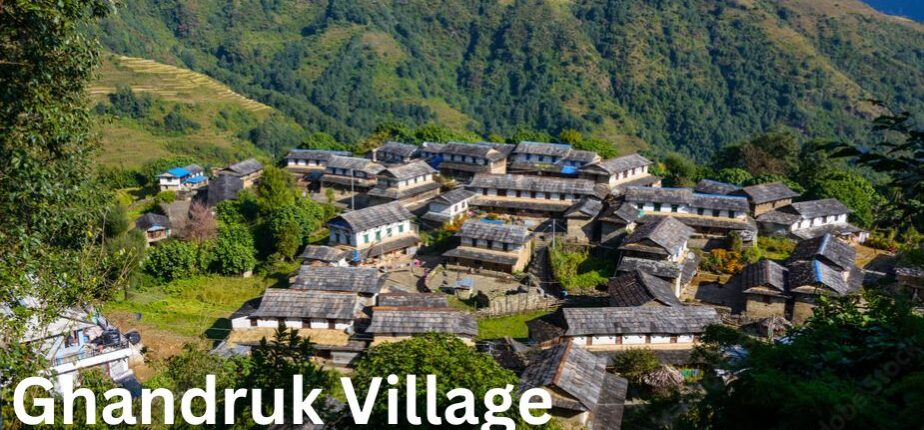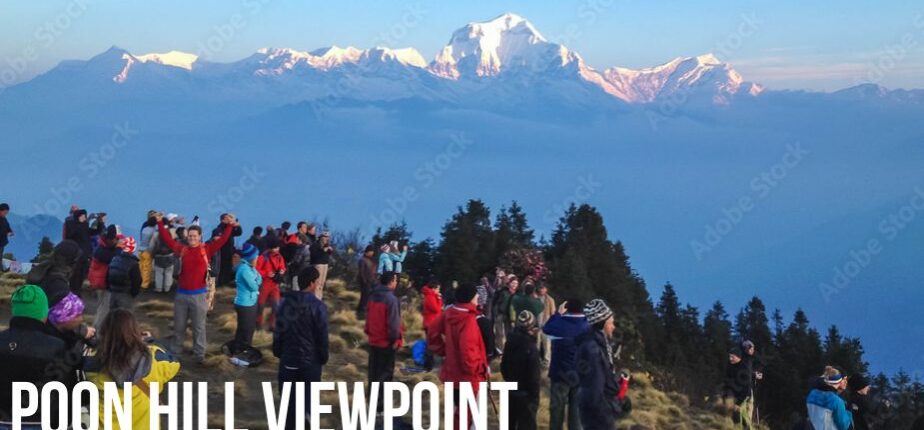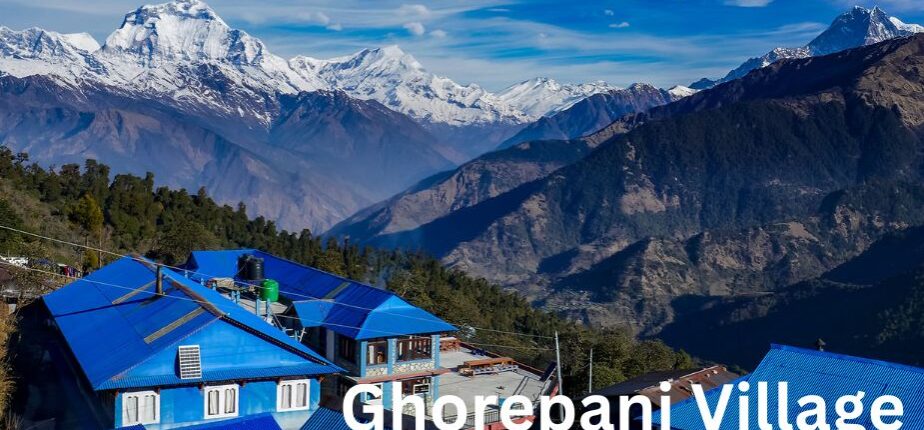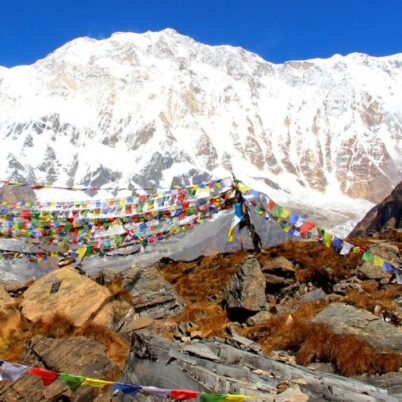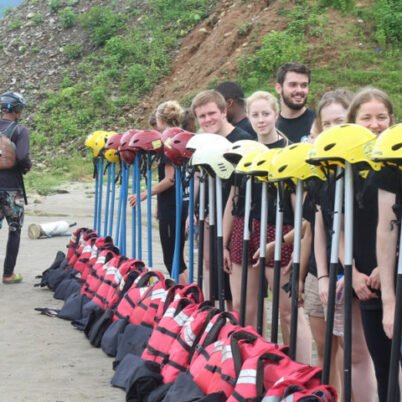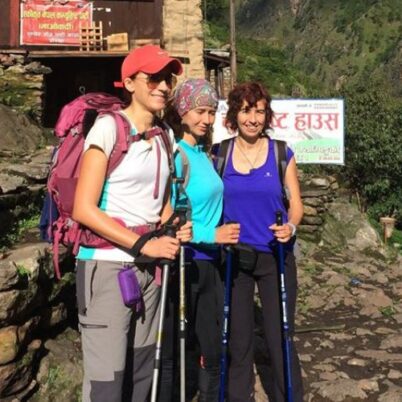
- Best Price Guarantee
- Secure Online Booking
- Flexible booking dates
- Owner operated company
- Decades of experience

Trip Facts
Highlights of Ghorepani Poon hill Trekking
- Panoramic Mountain Views from Poon Hill
- Cultural Immersion
- Lush Forests and Diverse Flora
- Scenic Landscapes
- Comfortable Tea Houses
- Accessible and Short Duration
- Wildlife and Birdwatching
Trip Overview
Ghorepani Poon Hill Trek is one of the most popular and accessible trekking routes in the Annapurna region of Nepal. It is renowned for its breathtaking views and rich cultural experiences. This trek is perfect for those seeking a short yet fulfilling adventure. The trail takes us a maximum height of up to 3,210 meters, a viewpoint, Poon Hill. The viewpoint offers panoramic vistas of the Annapurna and Dhaulagiri Mountain ranges. It is stunning, especially at sunrise.
The Ghorepani Poon Hill Trek begins with a short drive from Pokhara to Nayapul, the trekking starting point. The trek leads through diverse landscapes, including lush rhododendron and oak forests, terraced farmlands, and charming villages inhabited by the Gurung and Magar communities. Trekkers will have the opportunity to immerse themselves in the local culture and observe the traditional practices and hospitality of these indigenous groups.
The well-maintained trail includes numerous tea houses that provide comfortable accommodations and meals. Thanks to initiatives by the Annapurna Conservation Area Project, these lodges maintain high standards of hygiene and sustainability. Modern amenities like Wi-Fi and 4G network services are available in several locations, ensuring trekkers can stay connected.
Ideal for trekkers of all ages and experience levels, the Ghorepani Poon Hill Trek is a perfect blend of natural beauty and cultural richness. Its manageable altitude and well-trodden paths make it an excellent choice for those with limited time who want to experience the magic of the Himalayas without the strain of a prolonged high-altitude trek.
Ghorepani Poon hill Trekking Itinerary
Day 01 Arriva in Kathmandu (1,300 m)
Upon arrival at Kathmandu airport, our staff member will collect valued trekkers and transfer them to a hotel.
After checking into a hotel, and having refreshments, we will go to the Go Trekking Nepal office for official paperwork. If we have time, we go to explore the bustling touristy market Thamel.
In the evening you will be invited to attend a welcome dinner, organized by Go Trekking Nepal, in a restaurant. You will meet the trek leader and other fellow trekkers, who are going to Ghorepani Poon Hill Trek with you.

Duration
30 Minutes Drive
Distance
7 Km
Vehicle
Car / Van / JeepMeals
BreakfastAccommodation
Tourist Standard HotelDay 02 Going to Pokhara (9,00 m)
Earl morning, at 7 AM, we will board a bus and head to Pokhara. The road, from Kathmandu to Pokhara, is 200 kilometers, and it takes 7 to 8 hours long drive.
The bus journey will be scenic. The bus ride goes through Prithvi highway, the busiest road in Nepal, as it connects most of the other cities with Kathmandu.
From the bus window, you’ll be treated to a picturesque view of rural landscapes, terraced farms, charming villages, and bustling roadside shops and restaurants.
After having a couple of hours’ drive the road goes through the bank of the mighty Trisuli River. We stop for breakfast and continue to travel towards Pokhara.
Depending on road conditions, the bus arrives in Pokhara after 7 hours of drive. Upon arrival in Pokhara, we check into a hotel and go to hang out in the bustling touristy zone, Lakeside.
Overnight stay in Pokahra.

Duration
7 to 8 hours Drive
Distance
200 Km
Vehicle
Tourist BusMeals
BreakfastAccommodation
Tourist Standard HotelDay 03 Pokhara to Nayapul to Tikhedhunga (1,570m).
After enjoying a hearty breakfast, we set off in a car or jeep, depending on the group size, for a scenic one-and-a-half-hour drive to Nayapul, the starting point of our trek.
From Nayapul, we cross Birethati a checking point for permits and other required documents. The trail goes through lush forests, typical Nepalese villages, farmlands, etc.
Upon reaching Tikhedhunga, we check into a cozy teahouse lodge. After refreshing ourselves, we gather in the dining hall to read books, use the internet, play chess or other indoor games, and enjoy engaging conversations.
We will have a hearty dinner in the lodge and go to bed to relax from the day-long journey.
Overnight Stay in Tikhedhung

Duration
4 to 5 hours Trek
Distance
13 Km
Vehicle
00Meals
Breakfast, Lunch, DinnerAccommodation
Local TeahouseDay 04 Trek from Tikhedhunga to Ghorepani (2,850m)
The trail from Tikhedhunga ascends the steep, stone-paved steps to the village of Ulleri. On this challenging uphill path, careful footing is essential, and trekkers are advised to use a trekking pole for added stability and support.
To the north, beautiful mountain views of Annapurna South and Machhapuchhre (Fishtail) come into sight, while to the south, exhilarating views of valleys and the Himalayan foothills unfold.
After crossing Ulleri Village, the trail goes through the forest of rhododendrons, oak, and a mix of types of trees. We will reach a small settlement, Banthati, where we stop for lunch.
We reach Ghorepani after 7 to 8 hours of journey and check into a lodge. Trekkers will enjoy and relax in the room. If they are interested in exploring Ghorepani village our guide takes us to explore it.
Overnight Stay in Ghorepani

Duration
7 to 8 hours Trek
Distance
7Km
Vehicle
00Meals
Breakfast, Lunch, DinnerAccommodation
Local TeahouseDay 05 Trek from Ghorepani to Poon Hill (3,210m) to Tadapani (2,630m)
Early morning, around dawn, we hike to Poon Hill (3,210m) for a sunrise view and a panoramic vista of the mountain range.
Poon Hill is a famous viewpoint where many travelers come to catch a view of the sunrise and its reflection over the mountain peaks of Annapurna and Dhaulagiri. Almost at 360 degrees, the view of the mountain range and peaks of Annapurna I, Annapurna South, Dhaulagiri, and Machhapurchre are spotted.
Having a wonderful time in Poon Hill, we come back to the lodge and take breakfast then begin trek toward Tadhapani.
The trail gently ascends to Gurung Hill, another viewpoint comes across the trail, which is popular for jump-shot photography.
The trail descends through the Rhododendron Forest, crossing a small settlement Deurali.
After 5 to 6 hours of effort, we reach Tadhapani and check into a tea house. Tadhapani is a small Gurung settlement, from where the exhilarating view of Annapurna south, Gagpurna, and Machhapuchre mountain peaks appear in pretty close distance.
Overnight stay in Tadhapani

Duration
6 to 7 hours Trek
Distance
15 Km
Vehicle
00Meals
Breakfast, Lunch, DinnerAccommodation
Local TeahouseDay 06 Trek from Tadhapani to Ghandruk ( 2,012 m )
After having breakfast, we begin our trek to Ghandruk.The trail descends gently, passing through a dense forest of rhododendrons, oaks, bamboo, and other trees.
Upon arrival in Ghandruk, we will check into a lodge, freshen up, and set out to explore the village. Ghandruk is one of the largest settlements of the Gurung people, who are indigenous and traditionally known for animal husbandry and farming. Nowadays, they are involved in various businesses and services. The village itself is a typical Gurung village, with quaint houses featuring stone roofs, two-story buildings, and numerous huts for animals. Several Nepalese motion pictures have been shot here.
Our trek guide will take us on a tour of this beautiful village, allowing us to engage in short conversations with the locals and immerse ourselves in their culture. We will visit the Gurung Museum, where we can observe traditional tools and other artifacts used in earlier times. At the museum, we can also hire traditional Gurung dresses and take memorable photos by wearing them.
From Ghandruk, we will enjoy breathtaking views of Annapurna South, Gangapurna, and Machhapuchhre. The lowlands showcase beautiful Himalayan foothills with terrace farming. After exploring the village, we will return to the lodge and may have the opportunity to attend a traditional Gurung dance show, which is occasionally organized in the village.
Overnight Stay in Ghandruk

Duration
3 to 4 hours Trek
Distance
9 Km
Vehicle
00Meals
Breakfast, Lunch, DinnerAccommodation
Local TeahouseDay 07 Ghandruk to Nayapul to Pokhara(900 M)
After breakfast, we start our trek from Ghandruk to Nayapul. The trail descends gradually, passing through terraced fields and small villages, offering picturesque views of the surrounding landscape.
The trek from Ghandruk to Nayapul takes approximately 4-5 hours. Upon reaching Nayapul, we will meet our vehicle and drive to Pokhara. The drive takes about 1.5 hours, offering a relaxing journey with scenic views of the hills and valleys.
Upon arrival in Pokhara, we will check into our hotel. The rest of the day can be spent relaxing by the lakeside, exploring the city, or enjoying some of the activities Pokhara has to offer, such as boating on Phewa Lake or visiting the World Peace Pagoda.
In the evening, you can enjoy a delicious dinner at one of the many lakeside restaurants, reflecting on the incredible trek and the beautiful memories made along the way.

Duration
5 to 6 hrs Trek & 1.5 hrs drive
Distance
19 km
Vehicle
00Meals
Breakfast, Lunch, DinnerAccommodation
Local TeahouseDay 08 Departure from Pokhara
Depending on your schedule, spend more time exploring Pokhara or head back to Kathmandu or your next destination.

Duration
00
Distance
00
Vehicle
Car / Van ? JeepMeals
BreakfastAccommodation
Tourist Standard HotelTrip Information of Ghorepani Poon hill Trekking
Ghorepani Poon Hill Trekking: Essential Information
Ghorepani Poon Hill Trek is one of the most sought-after short treks in Nepal. It offers a blend of scenic landscapes, cultural immersion, and moderate trekking challenges. The trail make it suitable for a wide range of trekkers, from beginners to experienced hikers. Situated in the heart of the Annapurna region, this trek is known for panoramic Himalayan views and encounters with ethnic Gurung and Magar villages. Here are the essential details to consider before setting off on this incredible journey.
Location and Accessibility
The trekking trail is located in the Annapurna Conservation Area of western Nepal, with the nearest city being Pokhara. The journey starts with a drive from Pokhara to Nayapul or Tikhedhunga, the gateway to the Ghorepani trek. Alternatively, some prefer starting from Ghandruk.
This trekking route is relatively close to urban hubs, making it an accessible choice for trekkers with limited time. The entire journey can be completed within 4–6 days, depending on the pace and chosen route.
Best Time to Trek
The ideal seasons to trek to Ghorepani Poon Hill are spring (March to May) and autumn (September to November). During these periods, the weather is stable, skies are clear, and the panoramic views of Annapurna, Dhaulagiri, and Machhapuchhre (Fishtail) are at their finest.
- Spring: This season offers the chance to witness vibrant rhododendron blooms throughout the forest trails.
- Autumn: Trekkers enjoy pleasant temperatures, clear skies, and festive vibes, as it coincides with major Nepali festivals like Dashain and Tihar.
Trekking in winter (December to February) is possible but colder, especially at higher altitudes. Monsoon trekking (June to August) is less popular due to frequent rains, muddy trails, and leeches, though it offers lush greenery.
Level of Difficulty
The Ghorepani Poon Hill trek is classified as moderate in terms of difficulty. Daily walks of 4–6 hours are common, involving uphill and downhill trails with many stone steps. Though no technical skills are required, the trek demands decent physical fitness and stamina. Trekkers of all ages, including families with children, can comfortably complete the route.
Permits Required
To trek in the Annapurna region, you will need the following permits:
- Annapurna Conservation Area Permit (ACAP): This permit contributes to the conservation efforts in the Annapurna region.
- Trekkers’ Information Management System (TIMS) Card: Issued by the Nepal Tourism Board, it ensures your safety by tracking trekkers in the region.
Both permits can be obtained in Kathmandu or Pokhara. Some trekking agencies handle the permit process on behalf of their clients.
Accommodation and Food
The trail offers plenty of teahouse accommodation, which provides basic but comfortable lodging. Rooms usually include twin beds with blankets, though it is advisable to bring a sleeping bag for added warmth. Bathrooms might be shared, and hot showers are available for an extra fee in most places.
Meals include Nepali staples like ‘dal bhat’ (rice with lentil soup) and a variety of other options, such as noodles, soups, pasta, and momos (dumplings). Teahouses also serve hot drinks, including ginger tea, black tea, and coffee, which are perfect for chilly evenings.
Packing Essentials
While the trek is short, it’s important to pack wisely. Some key items include:
- Clothing: Moisture-wicking layers, fleece jacket, down jacket, trekking pants, and thermal wear
- Footwear: Sturdy trekking shoes with good grip and comfortable socks
- Accessories: Hat, gloves, sunglasses, and a rain jacket or poncho
- Gear: Trekking poles, a headlamp, and a water bottle with a purifier
- Personal Items: Sunscreen, lip balm, toiletries, and a basic first-aid kit
Since the weather in the mountains can be unpredictable, layering is essential. A rain cover for your backpack is recommended during the monsoon season.
Safety and Health Tips
- Hydration: Drink plenty of water to stay hydrated, especially when ascending steep sections.
- Pace Yourself: Avoid rushing, especially on uphill sections, to prevent exhaustion or altitude-related symptoms.
- Acclimatization: Though the altitude is not extreme, some trekkers might experience mild altitude discomfort at Ghorepani. Proper rest and slow ascent are key.
- Trekking Insurance: Having travel insurance that covers trekking activities is advisable for safety.
Local Culture and Etiquette
While trekking, it is important to respect the local culture and customs. Here are a few tips:
- Greet locals with “Namaste,” a common form of respect in Nepal.
- Seek permission before taking photographs of people or religious monuments.
- Dress modestly, especially in villages, to respect cultural norms.
- Support local teahouses and businesses to contribute to the community’s economy.
Connectivity and ATM Availability
Mobile networks are available along the trail but may be inconsistent at higher altitudes. Some teahouses provide Wi-Fi, though it might be slow and chargeable. It is recommended to carry cash in Nepali Rupees , as ATMs are not available on the trekking route, and card payments are rare.
Environmental Responsibility
Trekkers are encouraged to follow Leave No Trace principles to minimize environmental impact. Use reusable water bottles, avoid single-use plastics, and carry back any waste. The Annapurna Conservation Area emphasizes sustainable tourism, so respecting nature and local communities is crucial.
By considering these essential details, trekkers can enjoy the Ghorepani Poon Hill trek safely and comfortably while immersing themselves in Nepal’s rich culture and stunning natural beauty. Whether you are seeking mountain vistas, cultural insights, or a relaxing adventure, this trek offers an unforgettable experience for everyone.
Trip map of Ghorepani Poon hill Trekking
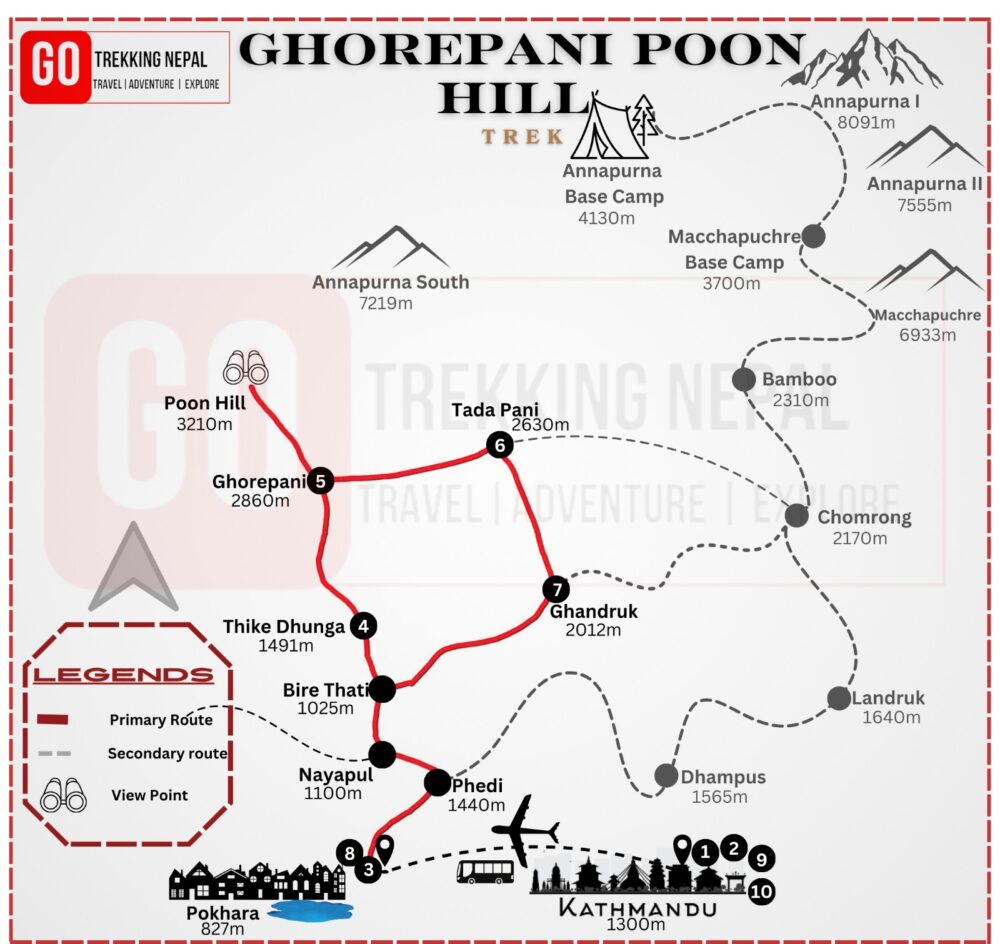
Frequently Asked Questions
How long does it take the Ghorepani Poon Hill Trek?
The trek typically takes between 4 to 6 days. It also depends on the route and pace of the trekker.
What is the best time to do the Ghorepani Poon Hill Trek?
The best times to trek Ghorepani Poon Hill Trek are during the pre-monsoon (March to May) and post-monsoon (September to November) seasons. During these periods, the weather is generally clear, offering the best views of the mountains.
What is the maximum altitude reached during the trek?
The highest point of the trek is Poon Hill, which stands at 3,210 meters.
Do I need a permit for the Ghorepani Poon Hill Trek?
Yes, the Ghorepani Poon Hill trekking routes comes inside Annapurna Conservation Area, you need two permits: the Annapurna Conservation Area Permit (ACAP) and the Trekkers’ Information Management System (TIMS) card.
What is the difficulty level of the trek?
The Ghorepani Poon Hill Trek is considered an easy-level trek, suitable for beginners with a reasonable level of fitness.
What kind of accommodation is available on the trek?
Teahouses and lodges are available along the trekking route. These offer basic but comfortable accommodation and meals. The managers of the Tea house and lodges are well-trained by ACAP.
What should I pack for the trek?
Essential items include good quality trekking shoes, warm clothing, rain gear, a sleeping bag, trekking poles, a daypack, water purification tablets or a water filter, and personal medication.
Can I trek solo or do I need a guide?
While it is possible to trek solo as the trails are well-marked, hiring a guide can enhance your experience by providing local knowledge and ensuring safety. Solo trekkers should be confident in their navigation and trekking abilities.
What are the main highlights of the trek?
Key highlights include the sunrise view from Poon Hill, the cultural experiences in Gurung and Magar villages, trekking through rhododendron forests, and the scenic terraced fields.
How do I get to the starting point of the trek?
The trek typically starts from Nayapul, which is a 1.5-hour drive from Pokhara. Pokhara is 200 km from Kathmandu. You can take a bus, take 7-8 hours’ drive, or fly 30 minutes.
- Best Price Guarantee
- Secure Online Booking
- Flexible booking dates
- Owner operated company
- Decades of experience


